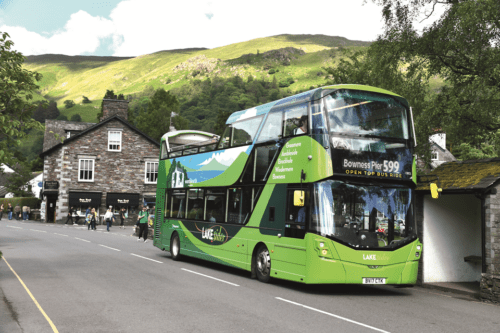
Steven Knight heads north to find out how easy it is to travel around the Lake District using only the bus (and a train) on a short break
I had planned the trip north to the Lakes with Mrs K, but it was a trip with a difference.
Firstly, it is the Lake District; that means water and lots of it, so surely that means lots of rain! What we did want to achieve was to find out how easy it was to travel around the area using only public transport. Yes, we did travel north using the car, but once we arrived at the farmhouse B&B, around mid-day on the Sunday, the engine was switched off. The car would not move again until we left on the Thursday afternoon.
The first challenge was to see how easy it was to plan the trip and find out the best ticket to use. Even with the £2 single bus fare, it would be somewhat expensive, so we hoped that a suitable weekly ticket would be available.
Having visited the area and many of its attractions in the past, this trip was more about the ‘sit back, relax and enjoy the journey’ theme. After all, some of the best views are from the top deck of a bus and even better on an open-top bus!
Firstly, a quick lesson. There is only one official lake in the Lake District – Bassenthwaite Lake. All the others are ‘meres’ or ‘waters.’ Referring to Windermere as Lake Windermere is, therefore, technically incorrect.
It was back in 1810 that William Wordsworth published his ‘Guide to the Lakes’ and 37 years later the Kendal & Windermere Railway reached Windermere.
The Lake District National Park was established in 1951 and in 2016 was extended. The Lake District itself covers 912 square miles (2,2362 square kilometres) and of its mountains, Scafell Pike, is the highest at 3,210 feet (978 metres). Windermere is the biggest of the ‘lakes’ at 10.5 miles long. The Lake District is the largest of the 13 national parks in England and the second largest in the UK. Oh, and did we say that the region has above average rainfall, but there again it needs to top up its Lakes, Meres and Waters!
Tourism is a major source of income for the area, with 18.14 million visitors in 2022 ploughing £2.14 billion into the local economy. There is no shortage of activities and attractions within the area, and beyond its boundaries, the area also being home to the largest population of red squirrels in the UK.
[…]
By subscribing you will benefit from:
- Operator & Supplier Profiles
- Face-to-Face Interviews
- Lastest News
- Test Drives and Reviews
- Legal Updates
- Route Focus
- Industry Insider Opinions
- Passenger Perspective
- Vehicle Launches
- and much more!


